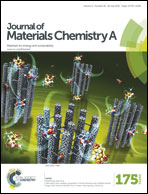From fibrous elastin proteins to one-dimensional transition metal phosphides and their applications†
Abstract
One-dimensional (1D) carbon-supported nanostructured CoP and FeP4 were prepared using fibrous elastin proteins that served as starting materials through an oil-phase method and the as-synthesized products were investigated for their lithium and sodium storage properties. The 1D CoP and FeP4 are composed of nanosized particles decorated on carbon supports. The 1D CoP and FeP4 nanostructures are ∼2 μm in length and 20–50 nm in diameter. The particles on the exterior of the 1D structure are 5–10 nm in diameter. To investigate the as-synthesized 1D TMPs in energy storage applications, the as-synthesized 1D CoP nanostructures are applied as an anode material in half-cells for LIBs and SIBs. For lithium storage performances, the anode delivers a specific capacity as high as ∼740 mAh g−1 at 0.2C and shows good rate performance and capacity retention as well as high rate capability (e.g. a stable specific capacity of ∼365 mAh g−1 for 120 cycles at 3.0C). In SIBs, at 0.2 and 5.0C, the specific capacities of 491.60 and 314.84 mAh g−1 are delivered, respectively. When tested at 1.0, 2.0, and 5.0C, the specific capacities are stable at ∼400, 360, and 300 mAh g−1 over 250, 250, and 1000 cycles, respectively.


 Please wait while we load your content...
Please wait while we load your content...